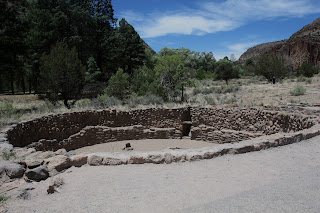The best part of our stay in Projoaque,NM was a trip we took
to Bandelier National Monument. On the
way to Bandelier we decided to take make it a loop drive which took us through
the Jemez Mountains and some pretty nice scenery.
The first place we came to was Los Alamos which is the first Atomic Bomb was made. We wanted to see what it looked like as the city was created to hold the workers of the Manhattan Project. At the time it was a pretty hush, hush place. So secret that if you were born at Los Alamos during the war your birth certificate showed a PO Box number as your place of birth.
We stopped at the visitors centre and found out the top
thing on the tourist list was the Bradbury Museum. We didn’t bother taking it in as we had been
part of a pretty intense tour at the Museum in Santa Fe. We did find out that the research facility is
still a big part of Los Alamos and is the major employer. We also found out that it is still a pretty
secret place. On our way out of town we
came to a security stop where we had to show ID. It was pointed out to us that we were not
allowed to take any pictures of any part of the facility as we drove by
it. Hmmmmm, I wonder what they are
making now.
We were getting close to Bandelier and were around 7000 feet
which gave us a good view of the area.
In the distance was the smoke from a forest fire that had started last
night. It was very visible from our
camping spot as we are camped at the base of the mountain. As we watched it over the next two days it
was evident that the wind was pushing it east and not presenting any danger to
the town.
We arrived at Bandelier National Monument and took in the visitors center to learn a little bit about the history of the area.
Bandelier protects over 33,000 acres of rugged but beautiful canyon and mesa country as well as evidence of a human presence going back over 10,000 years. PetroGlyphs, dwellings carved into the soft rock cliffs, and standing masonry walls pay tribute to the early days of a culture that still survives in the surrounding communities.
Bandelier's human history extends back for over 10,000 years when nomadic hunter-gatherers followed migrating wildlife across the mesas and canyons. By 1150 AD Ancestral Pueblo people began to build more permanent settlements. Reminders of these past times are still evident in the park as are the strong ties of the modern Pueblo people. The park rangers are not sure if the permanent dwellings were used in conjunction with the cave dwellings or if they were a step up.
We were only 100
yards into our hike when this little fellow crossed in front of us. As we got closer we could see that there were
three of them. However, I was only able
to get a couple of pictures of one of them.
The first sign of human existence we came upon was a community centre and an apartment building. The community centre is an underground structure and was an important part of the ceremonial cycle and culture. It is called a kiva and at the time of its use would have had a covering. What I called an apartment building was actually the remains of a village. You have to imagine that these ruins were at one time were two stories and built a circle with multiple kiva’s in the middle.
Our hike then led
us to the base of the cliffs and the cave dwellings. They have not been able to specifically
determine if the cave dwellings were before the houses or were lived in at the
same time. The cliffs are made out of
volcanic tuff which is pretty soft compared to most rock. These cave rooms or Cavates were dug out of
the cliff walls using only stone tools.
The lower caves were usually plastered and painted while the ceilings
were smoke-hardened.
One of the last
dwellings we saw was the longhouse, a group of housing units that could be
several stories high. This one looked to
be two stories and would house extended families.
Above the top row
of holes there are many petroglyphs. At
one time it was considered rock art but it is becoming apparent that these
drawings had much deeper and specific meanings to the peoplwho carved them. They are hard to see as they have shrunk with time, I took pictures anyways.
The long house and
petroglyphs was as far as we could go as the rest was closed. Fire restrictions.
I took some
pictures of some of the unique shapes and configurations we saw while we were
hiking in the park.
On our way back to
the RV park we went through the town of White Rock. We only made one stop here and that was at an
overlook. We got a real good look at the
Rio Grande and the Rio Grande Valley. We also had a good look at the fire
burning near our campsite.
We left the lookout
and headed back to the RV park to start packing up. We are leaving In the morning for Broomfield
which is about 180 miles northwest of here.
































No comments:
Post a Comment